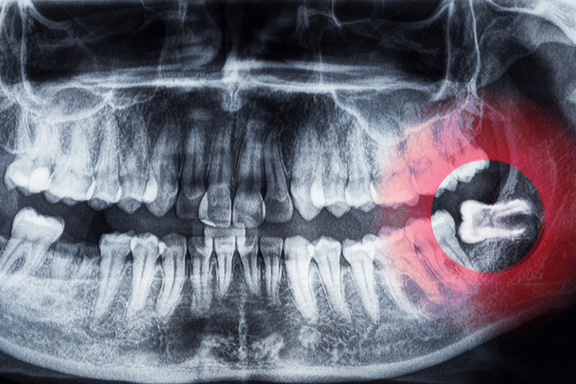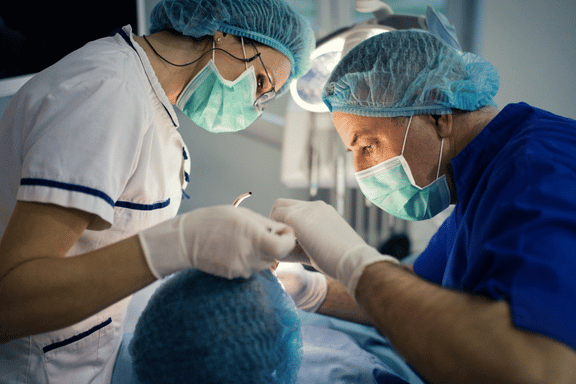


When it comes to dental health, wisdom teeth removal can feel like a daunting task, but for many, it’s an essential step toward maintaining a healthy mouth.
Here at Mahogany Oral Surgery in Calgary, we understand that wisdom teeth recovery is a process, but with the right preparation and care, you’ll be back on your feet in no time. Whether you’re dealing with impacted wisdom teeth, severe pain, or just preparing for future oral health problems, our goal is to make your wisdom teeth removal recovery journey as smooth as possible.
Here we’ll take you through everything you need to know about wisdom teeth removal, why it’s necessary, and how to ensure your wisdom teeth removal recovery goes off without a hitch.
Preparing for Wisdom Teeth Removal
Preparing for wisdom teeth removal is crucial to ensure a smooth and comfortable recovery. Here are some practical tips to help you get ready for your procedure:
- Stop eating and drinking at least 8 hours before the procedure: This helps prevent complications during anesthesia.
- Avoid smoking and tobacco products for at least 24 hours before the procedure: Smoking can interfere with healing and increase the risk of complications.
- Wear comfortable clothing and avoid wearing jewelry or accessories that may interfere with the procedure: Comfort is key, and loose clothing will help you relax.
- Arrange for someone to drive you home after the procedure: Anesthesia can impair your ability to drive, so having a friend or family member to take you home is essential.
- Inform your surgeon about any medications you are taking, including over-the-counter medications and supplements: This ensures your oral surgeon can provide the safest care possible.
Why Remove Impacted Wisdom Teeth in the First Place?

Imagine your mouth like a jigsaw puzzle. Most of the pieces fit together nicely, but then come the wisdom teeth—the last adult teeth to arrive, often without enough room to fit properly.
These third molars can cause a host of issues if they don’t form properly, often leading to severe pain, gum disease, tooth decay, and even damage to your other teeth. This is why so many people opt to have their wisdom teeth removed, even before problems arise.
According to the Canadian Association of Oral and Maxillofacial Surgeons (AAOMS), approximately 85% of people will need to have their wisdom teeth extracted.
If left untreated, wisdom teeth can become impacted, meaning they don’t emerge fully from the gum line, which can lead to infections, cysts, and damage to neighbouring teeth. This is one of the main reasons early wisdom teeth removal is recommended for long-term oral health and to avoid potential complications later on.
By proactively having your wisdom teeth removed, you reduce the risk of future oral health problems and improve your overall dental hygiene. Early wisdom teeth removal recovery is often easier when complications like infection or impaction are avoided.
Understanding the Benefits
Wisdom teeth removal can have several benefits, including:
- Relieving pain and discomfort caused by impacted wisdom teeth: Impacted wisdom teeth can cause significant pain and pressure.
- Preventing infection and abscesses: Removing wisdom teeth can reduce the risk of infections that can spread to other areas.
- Reducing the risk of tooth decay and gum disease: Wisdom teeth can be difficult to clean, leading to decay and gum issues.
- Improving oral hygiene and overall dental health: With fewer teeth to manage, maintaining oral hygiene becomes easier.
- Enhancing the appearance of your smile: Removing problematic wisdom teeth can prevent misalignment and crowding.
What Does the Wisdom Teeth Removal Procedure Involve?

The wisdom teeth removal procedure may sound intimidating, but it’s a relatively routine and efficient process. At Mahogany Oral Surgery in Calgary, we take every step to ensure that you’re comfortable and prepared for the wisdom tooth procedure. Your oral surgeon will assess whether your wisdom teeth are impacted or fully erupted, which will determine the complexity of the surgery.
In some cases, general anesthesia or IV sedation is used to keep you comfortable and pain-free throughout the procedure.
Once sedated, the oral surgeon will make small incisions in the gums (if necessary) to access the wisdom teeth. If the wisdom teeth are impacted, they may need to be broken into smaller sections for easier removal. After the extraction, the surgical sites are carefully cleaned, and stitches are often used to promote healing.
The entire process typically takes less than an hour, depending on how many wisdom teeth are being extracted. Your oral surgeon will give you clear instructions to follow during your wisdom teeth removal recovery, which includes managing pain, reducing swelling, and taking good care of the extraction sites.
What to Ask Your Surgery Team
Before your wisdom teeth removal, make sure to ask your dentist:
- What type of anesthesia will be used during the procedure?: Understanding your anesthesia options can help you feel more prepared.
- How long will the procedure take?: Knowing the duration can help you plan your day.
- What are the risks and complications associated with wisdom teeth removal?: Being aware of potential risks can help you make informed decisions.
- What is the expected recovery time?: This helps you plan for time off work or school.
- What are the post-operative instructions?: Clear instructions are crucial for a smooth recovery.
Wisdom Teeth Removal Recovery: The First 24 Hours

The first 24 hours after wisdom teeth removal are crucial for setting the stage for a smooth recovery. During this time, the body starts the wound healing process, and it’s important to protect the extraction sites to avoid complications like dry socket. The blood clot that forms at the extraction sites is essential for proper healing, and you must take care not to disturb it.
Immediately after the surgery, gauze will be placed over the extraction sites to help absorb excess blood and promote clot formation.
It’s common to experience some mild bleeding during the first few hours of wisdom teeth removal recovery, but this should subside as the blood clot forms properly. Applying an ice pack to your cheeks in 20-minute intervals will help reduce swelling and ease discomfort. Pain medication prescribed by your oral surgeon will help manage any uncomfortable pain during the first day.
Avoiding any vigorous activities, especially drinking through a straw or eating crunchy foods, is critical. These actions can dislodge the blood clot, slowing your recovery and potentially leading to dry socket, a painful condition where the healing blood clot is disrupted. Additionally, taking pain medication as prescribed is essential for managing pain and inflammation effectively.
Immediate Care Essentials
After your wisdom teeth removal, make sure to:
- Follow your dentist’s instructions for pain management and medication: Proper pain management is key to a comfortable recovery.
- Apply an ice pack to the affected area to reduce swelling and pain: Ice packs can help minimize swelling in the first 48 hours.
- Eat soft foods for the first few days, such as yogurt, scrambled eggs, and mashed potatoes: Soft foods are gentle on the healing gums.
- Avoid drinking through a straw or spitting, as this can dislodge the blood clot: Protecting the blood clot is essential to prevent dry socket.
- Keep the extraction site clean by rinsing with salt water and gentle brushing: Maintaining cleanliness helps prevent infection.
Days 2-4: Focusing on Continued Healing
As you move into days two through four of your wisdom teeth recovery, you’ll begin to notice that the swelling and discomfort start to subside. However, it’s still important to manage the healing process carefully.
Using a saltwater rinse to gently cleanse your mouth can help prevent infection while soothing the gums. Avoid vigorous rinsing, as this can disrupt the blood clots at the extraction sites.
Swelling can persist during this stage, so continue using an ice pack as needed, and consider switching to heat therapy, like warm compresses, to further aid in reducing swelling. Your oral surgeon may recommend over-the-counter pain relievers like ibuprofen to help manage lingering discomfort.
Eating soft foods during this stage is key to ensuring a smooth wisdom teeth removal recovery. Foods like scrambled eggs, mashed potatoes, and applesauce will be easy on your healing gums, allowing you to nourish your body without irritating the surgical sites.
Managing Pain and Swelling Effectively

Managing pain and swelling effectively is central to a successful wisdom teeth recovery. Your oral surgeon will likely prescribe pain medication to help control the severe pain that can accompany wisdom teeth extraction, especially when the teeth are impacted. Make sure to take your prescribed medication as directed and complement it with over-the-counter anti-inflammatories like ibuprofen to manage pain and reduce inflammation.
Swelling usually peaks around 48 hours after surgery, but this can vary depending on how many wisdom teeth were extracted and whether or not they were impacted. To manage this swelling, continue using an ice pack in the first two days. After 48 hours, you may switch to warm compresses to improve circulation and speed up the healing process. Keeping your head elevated, especially while sleeping, can also help reduce swelling and ensure your wisdom teeth removal recovery progresses smoothly.
It’s important to monitor for any unusual signs like excessive bleeding, nose bleeding, or worsening pain. These could indicate complications, so don’t hesitate to reach out to your oral surgeon if you experience any of these issues.
Preventing Dry Socket During Wisdom Teeth Removal Recovery
One of the most common complications during wisdom teeth recovery is dry socket, which occurs when the protective blood clot is dislodged or doesn’t form properly. This condition can be very painful and prolong the healing process. To avoid dry socket, it’s essential to be careful in the first few days after surgery.
Avoiding suction-related activities like using a straw or smoking is crucial. These actions can easily dislodge the blood clot, exposing the bone and nerves beneath. Maintaining a soft diet is also vital in preventing irritation at the extraction sites.
Refrain from smoking or consuming spicy foods during your wisdom teeth removal recovery. Both can irritate the healing gums and increase your chances of developing dry socket.
What Foods Can You Eat During Wisdom Teeth Removal Recovery?

Diet plays a significant role in your wisdom teeth recovery. In the first few days after surgery, you’ll need to stick to a soft food diet to avoid disturbing the surgical sites. This means avoiding crunchy food, chewy foods, and anything that requires extensive chewing. These types of foods can not only irritate the healing gums but also risk dislodging the blood clot.
Good choices for your soft food diet include:
- Smoothies (without straws), or ice cream
- Mashed potatoes
- Yogurt
- Applesauce
- Soup (make sure it’s not too hot)
- Scrambled eggs
As you progress through your recovery, you can begin incorporating heartier food like soft pasta, pancakes, and well-cooked vegetables into your meals. Always test out solid foods carefully, and if any discomfort arises, switch back to softer foods.
How Long Does Wisdom Teeth Removal Recovery Take?
Wisdom teeth recovery times can vary depending on factors like age, the complexity of the surgery, and how well you follow post-operative care instructions. Generally, most people find that they feel significantly better after about three to four days, though full recovery can take a couple of weeks.
In the first week, you should experience a decrease in pain, swelling, and discomfort. By the end of the first week, many people are able to return to normal activities, though you’ll want to continue avoiding chewy foods, crunchy food, and spicy foods for a little longer. You should also avoid smoking and drinking alcohol during the recovery period, as both can interfere with the healing process.
For the next few weeks, your body will continue to heal internally at the surgical sites. While the outward signs of surgery—like swelling—should have diminished, the bone and gum tissue beneath the surface will take longer to fully heal.
Conclusion: A Smooth Wisdom Teeth Removal Recovery Is Within Reach

At Mahogany Oral Surgery in Calgary, we know that wisdom teeth recovery can feel overwhelming, but with the right care and preparation, the healing process can be much smoother.
By following your oral surgeon’s guidance, preventing complications like dry socket, and taking a proactive approach to pain management, you’ll find that your wisdom teeth removal recovery is well on track.
Most importantly, remember that this procedure is a vital investment in your oral health, helping you avoid more severe issues like impacted wisdom teeth, infection, or damage to your neighbouring teeth down the line.
So, if you’re in SE or SW Calgary or the surrounding communities and are ready to take the next step in your oral health journey, Mahogany Oral Surgery is here to help. With proper care, you’ll navigate your wisdom teeth removal recovery with ease, and enjoy a healthier, pain-free smile for years to come.


